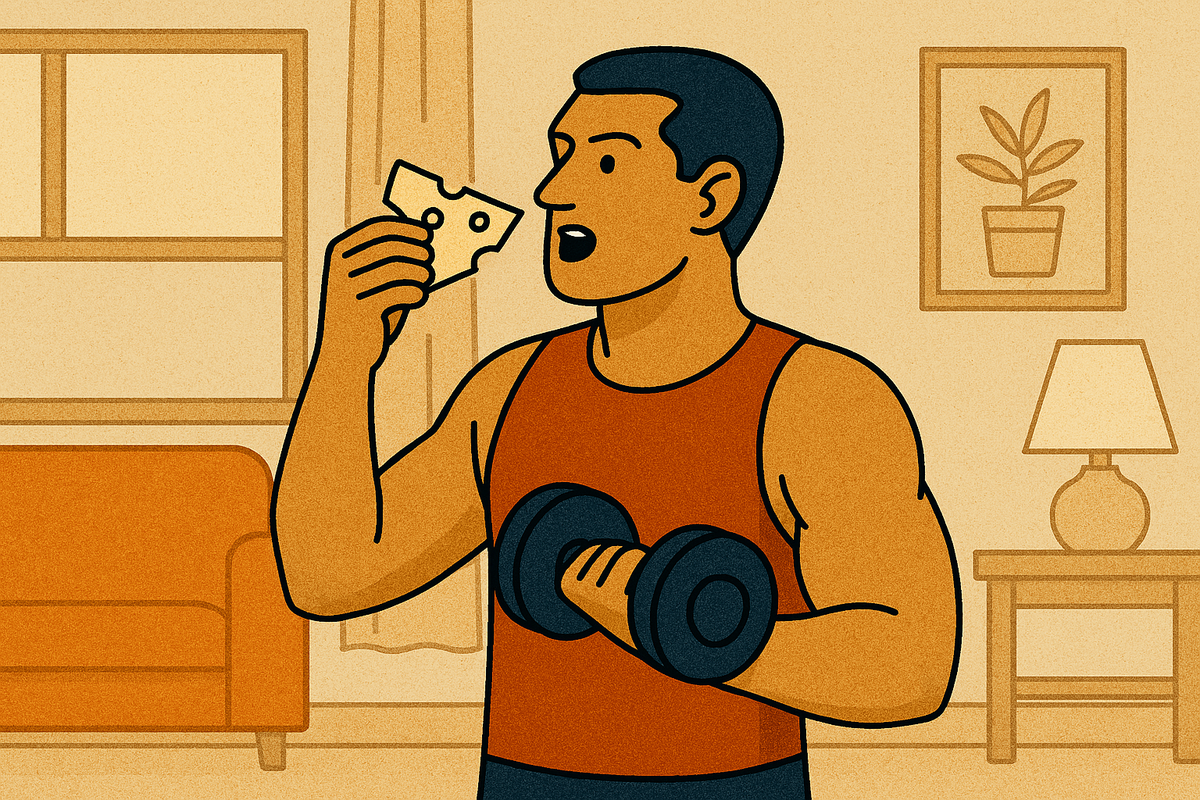
Looking to maximize your resistance training benefits with something tasty from your fridge? Recent research suggests adding cheese to your workout routine might do more than just please your taste buds—it could optimize your body composition and even positively influence your gut microbiome.
A fascinating study published in the Journal of Exercise Science & Fitness by researchers Yi-Hsuan Lin, Xue-Han Li, and colleagues from Beijing Sport University examined how combining resistance training with cheese supplementation affected body parameters and gut bacteria in healthy adults.
The Cheese-Training Combo Study
The researchers recruited 35 untrained male adults and divided them into four groups to undergo a 4-week resistance training program (3 times per week). The twist? Three of the groups received different amounts of cheese on their training days:
- Control group: resistance training only
- Low-dose group: 108g of cheese (6.7g of food-borne protein)
- Medium-dose group: 216g of cheese (13.4g of food-borne protein)
- High-dose group: 324g of cheese (20.1g of food-borne protein)
The resistance training program was comprehensive, including chest presses, leg presses, seated rowing, knee extensions, and triceps pushdowns. Each exercise consisted of 3 sets of 8-12 repetitions at 70% of their repetition maximum, with 2-minute rest periods between sets.
The Surprising Benefits
After just 4 weeks, the results were eye-opening—especially for the medium-dose group. Compared to the low-dose group, those consuming a medium amount of cheese showed:
- Lower body weight and BMI
- Reduced body fat mass and body fat percentage
- Lower total cholesterol and LDL (the “bad” cholesterol)
- Higher HDL (the “good” cholesterol)
Interestingly, all groups showed improved muscle strength regardless of cheese consumption, suggesting that the resistance training itself was effective for strength gains across all participants.
What’s Happening in Your Gut?
Perhaps the most intriguing finding was the effect on gut bacteria. The researchers collected fecal samples throughout the study and found that different doses of cheese altered the intestinal microbiota composition.
The abundance of beneficial bacteria varied between groups, with some notable differences:
- The low-dose group had higher levels of Actinobacteria
- The medium and high-dose groups had lower levels of Erysipelotrichaceae (a family of bacteria associated with lipid metabolic disorders)
- The high-dose group showed an increasing trend in microbial diversity
These changes might explain why the medium and high-dose groups saw improvements in body composition and lipid profiles.
The Goldilocks Zone: Not Too Little, Not Too Much
One key takeaway from this research is that more isn’t always better. The medium dose (216g of cheese providing 13.4g of food-borne protein) appeared to be the “sweet spot” for most benefits.
The researchers suggest that the low protein dose may not have been sufficient to alter body parameters, while the high dose didn’t provide significantly greater benefits than the medium dose.
For everyday athletes looking to enhance their resistance training, this research suggests that incorporating a moderate amount of cheese into your diet might be a simple, accessible way to boost results beyond what exercise alone can achieve.
Next time you hit the gym, perhaps consider having some cheese as part of your pre or post-workout nutrition—your muscles, body composition, and even your gut microbiome might thank you!
This article is based on research by Yi-Hsuan Lin et al., published in the Journal of Exercise Science & Fitness, Volume 22, Issue 2.
Discover More
- Does Swearing Make You Stronger? the Surprising Science Behind Cursing and Performance
- Power Up Your Performance With Probiotics: How Gut Health Could Be Your Secret Weapon
- Move Your Mood: How Exercise Lifts Depression and Anxiety During Menopause
- The Weekend Warrior vs. Regular Exercise: What's Best for Slowing Down Your Biological Clock?
- Can Creatine Save Your Workout When Cutting Carbs?
- Carnivore Diet for Athletes: Do You Need Carbs After All?
- Mix It Up! How to Combine Cardio and Strength Training for Maximum Results
- Rocking Your Walk: How Unstable Shoes Could Strengthen Your Feet and Improve Your Balance
- Trail Running Safety: Navigate the Path to Injury-Free Adventures
- Tech Your Way to Better Fitness: How Older Adults Are Using Digital Tools to Stay Active
- Rest Periods Matter: Finding Your Sweet Spot for High-Intensity Sprint Training
- Supercharge Your Jump: How Adding Bands to Your Deadlift Can Boost Performance
- Caffeine Before Exercise: Is Your Pre-Workout Cup of Joe Actually Helping You Burn Fat?
- Paws-Itively Perfect Exercise: How Your Dog Can Be Your Best Workout Partner
- The Long and Short of It: How Pole Length Can Boost Your Cross-Country Skiing Performance
- Time-Restricted Eating: Get Leaner Without Losing Your Gains
- Boost Your Strength & Shed Fat: Essential Amino Acids + Resistance Training
- Finding Your Perfect Fit: How Footwear Affects Performance and Injury Risk
- HIIT vs. Moderate Exercise: The Mood Rollercoaster Your Workout Takes You On
- Hydration Hype: Do Specialty Drinks Boost Exercise Performance? See more
